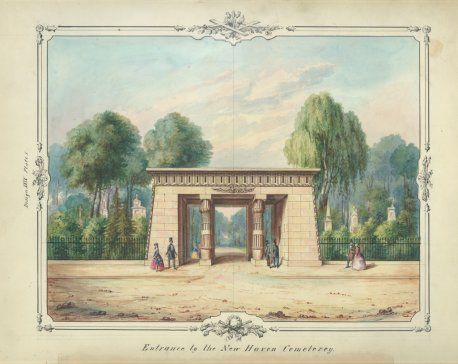Entrance to the New Haven Cemetery
Overview
Entrance to the New Haven Cemetery [ edit ]
The architect Henry Austin designed only one known Egyptianizing monument during his career: the entrance of the New Haven Burial Ground (commonly known as the Grove Street Cemetery). The sloping exterior combined with the overhanging cornice captures the essential features of an ancient Egyptian pylon, or gateway. The very shape of the pylon was a solar symbol in ancient Egyptian thought, and Austin thus unknowingly used an architectural form that expressed eternal renewal and resurrection. More specifically, Austin may have derived inspiration from temples such as Dendera and Esna North, where the hypostyle hall occupies a large room with the overall shape of a pylon, the forward columns—with curtain walls—forming part of the façade. Although the study of the ancient Egyptian language and the large corpus of Egyptian religious texts were in their infancy when Austin began the design on this gateway in 1839, the published results of the Napoleonic expedition to Egypt provided ample visual references for Austin’s monument (O’Gorman, Henry Austin, p. 119).
The faithful reproduction of Egyptian architectural details can be seen in a juxtaposition of the New Haven Cemetery gate with one of Austin’s potential ancient inspirations: the temple of Esna North. The overall proportions of the two facades are similar and show neither the extreme horizontal emphasis of John Haviland’s New York Halls of Justice and House of Detention (the “Tombs”) nor the final, vertical phase of Egyptianizing architecture, such as the designs of A.J. Davis (Carrott, Egyptian Revival, pp. 66-72). The edges of the pylon are framed by appropriate ancient Egyptian details. The torus molding on each exterior corner and below the cornice has accurate incised details, originally representing rope bindings around a reed core, but a stylized feature by the time of the Egyptian New Kingdom. The cavetto cornice of Austin’s gateway contains alternating groups of vertical lines and oval depressions, again accurately reproducing the designs on original cavetto cornices; in ancient Egyptian temples, the ovals decorating the cornice are actually cartouches (royal name rings), although as shown in the Description drawing of Esna North, the cartouches could be empty and thus easily reinterpreted as a geometric design.
At the center of the cornice is a winged sun-disk with two pendant cobras; these solar serpents were called iareret in Egyptian, thus giving us, via Greek, the specific designation uraeus. The details of the winged sun-disk on Austin’s gateway are impressive and correspond to the three different types of feathers shown on well-executed ancient examples. The detailing of the cobras on the New Haven gateway betrays the hand and aesthetics of the nineteenth century sculptor—while the overall shape mimics ancient prototypes, the ridged backs and unusually-shaped heads are invented details. The two columns of the New Haven Cemetery gate are stylized versions of the closed papyrus-cluster column. The plain abacus is typical in ancient Egyptian columns, and although more angular than Egyptian papyrus columns, the capitals in Austin’s design capture the overall form and impression of a closed papyrus flower. The collar and shaft of the column are also based directly on ancient Egyptian forms, with several distinct zones of decoration. The columns of the now-destroyed temple of Hermopolis Magna, images of which would have been readily accessible to Austin in the Description de l’Égypte (Antiquités, vol. 4, pls. 51-52) are a possible prototype for Austin’s design. A notable difference between Austin’s cemetery gateway and other Egyptian revival cemetery monuments lies in the depth of the New Haven gateway. Other cemetery gateways of the 1830’s and 1840’s, including the first major Egyptian Revival cemetery gate at Mount Auburn, Massachusetts, and the designs proposed for the Laurel Hill Cemetery, are shallow facades, more akin to tall Ptolemaic propylaea, such as those as Karnak and Dendera temples. Austin’s design, on the other hand, attempts to express the depth of an Egyptian temple’s hypostyle hall through the inclusion of a square column behind each main column. Such square columns appear within several temples depicted in the plates of the Description de l’Égypte, including at least two—the peripteral temples of Amunhotep III at Elephantine and Thutmose III at Elkab—that are no longer extant; in fact, both of these small peripteral temples employ the closed papyrus capitals, like Austin’s gate. Austin’s original water-color differs from the completed design in the transformation of the lintel to add the Biblical quote “The dead shall be raised” (1 Corinthians 15:52), moving the winged sun-disk to the cornice.
Date
1839-1848
Provenance
America
Material
Engraving and watercolor on paper
Museum
Henry Austin Papers, Manuscripts and Archives, Yale University Library
Accession Number
mssa.ms.1034,box 2 folder 27
R. Carrott, The Egyptian Revival, Its Sources Monuments and Meaning 1808-1858 (Berkeley, 1978), pp. 90-92, 143.
J.S. Curl, The Egyptian Revival, Ancient Egypt as the Inspiration for Design Motifs in the West, 3rd ed. (London, 2005), p. 300.
J. O’Gorman, Henry Austin: in every variety of architectural style (Middletown, CT, 2008), pp. 117-120.
S. Trafton, Egypt Land, Race and Nineteenth-Century American Egyptomania (Durham, 2004), pp. 156-164.









